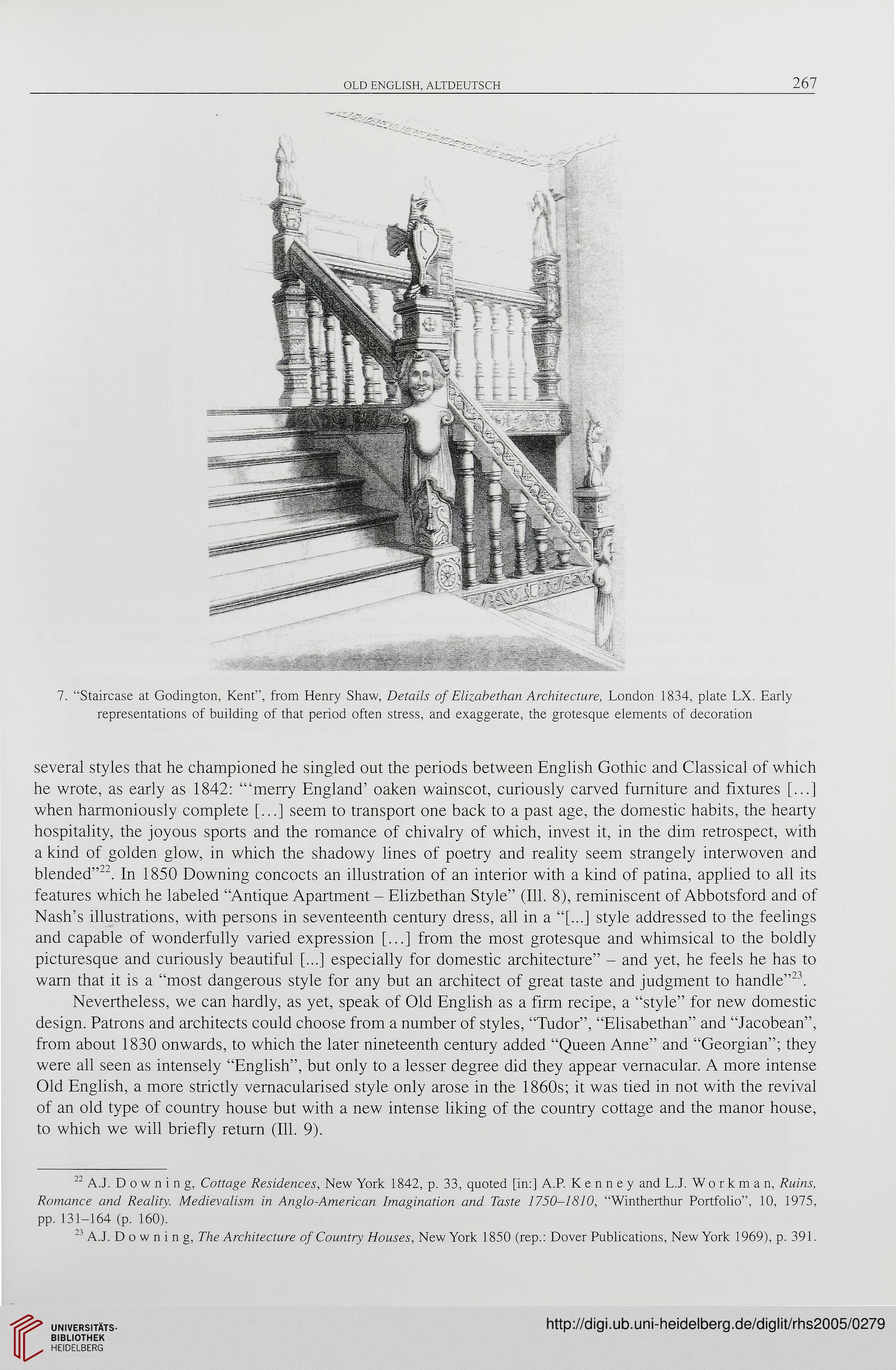OLD ENGLISH. ALTDEUTSCH
267
7. "Staircase at Godington, Kent", from Henry Shaw, Détails of Elizabethan Architecture, London 1834, plate LX. Early
représentations of building of that period often stress, and exaggerate, the grotesque éléments of décoration
several styles that he championed he singled out the periods between English Gothic and Classical of which
he wrote, as early as 1842: '"merry England' oaken wainscot, curiously carved furniture and fixtures [...]
when harmoniously complète [...] seem to transport one back to a past âge, the domestic habits, the hearty
hospitality, the joyous sports and the romance of chivalry of which, invest it, in the dim retrospect, with
a kind of golden glow, in which the shadowy lines of poetry and reality seem strangely interwoven and
blended"22. In 1850 Downing concocts an illustration of an interior with a kind of patina, applied to ail its
features which he labeled "Antique Apartment - Elizbethan Style" (111. 8), reminiscent of Abbotsford and of
Nash's illustrations, with persons in seventeenth century dress, ail in a "[...] style addressed to the feelings
and capable of wonderfully varied expression [...] from the most grotesque and whimsical to the boldly
picturesque and curiously beautiful [...] especially for domestic architecture" - and yet, he feels he has to
warn that it is a "most dangerous style for any but an architect of great taste and judgment to handle"23.
Nevertheless, we can hardly, as yet, speak of Old English as a firm recipe, a "style" for new domestic
design. Patrons and architects could choose from a number of styles, "Tudor", "Elisabethan" and "Jacobean",
from about 1830 onwards, to which the later nineteenth century added "Queen Anne" and "Georgian"; they
were ail seen as intensely "English", but only to a lesser degree did they appear vernacular. A more intense
Old English, a more strictly vernacularised style only arose in the 1860s; it was tied in not with the revival
of an old type of country house but with a new intense liking of the country cottage and the manor house,
to which we will briefly return (111. 9).
22 A.J. Downing, Cottage Résidences, New York 1842, p. 33, quoted [in:] A.P. К e n n e y and L.J. W о г к m a n, Ruins,
Romance and Reality. Medievalism in Anglo-American Imagination and Taste 1750-1810, "Wintherthur Portfolio", 10, 1975.
pp. 131-164 (p. 160).
23 A.J. Downing, The Architecture of Country Houses, New York 1850 (rep.: Dover Publications, New York 1969), p. 391.
267
7. "Staircase at Godington, Kent", from Henry Shaw, Détails of Elizabethan Architecture, London 1834, plate LX. Early
représentations of building of that period often stress, and exaggerate, the grotesque éléments of décoration
several styles that he championed he singled out the periods between English Gothic and Classical of which
he wrote, as early as 1842: '"merry England' oaken wainscot, curiously carved furniture and fixtures [...]
when harmoniously complète [...] seem to transport one back to a past âge, the domestic habits, the hearty
hospitality, the joyous sports and the romance of chivalry of which, invest it, in the dim retrospect, with
a kind of golden glow, in which the shadowy lines of poetry and reality seem strangely interwoven and
blended"22. In 1850 Downing concocts an illustration of an interior with a kind of patina, applied to ail its
features which he labeled "Antique Apartment - Elizbethan Style" (111. 8), reminiscent of Abbotsford and of
Nash's illustrations, with persons in seventeenth century dress, ail in a "[...] style addressed to the feelings
and capable of wonderfully varied expression [...] from the most grotesque and whimsical to the boldly
picturesque and curiously beautiful [...] especially for domestic architecture" - and yet, he feels he has to
warn that it is a "most dangerous style for any but an architect of great taste and judgment to handle"23.
Nevertheless, we can hardly, as yet, speak of Old English as a firm recipe, a "style" for new domestic
design. Patrons and architects could choose from a number of styles, "Tudor", "Elisabethan" and "Jacobean",
from about 1830 onwards, to which the later nineteenth century added "Queen Anne" and "Georgian"; they
were ail seen as intensely "English", but only to a lesser degree did they appear vernacular. A more intense
Old English, a more strictly vernacularised style only arose in the 1860s; it was tied in not with the revival
of an old type of country house but with a new intense liking of the country cottage and the manor house,
to which we will briefly return (111. 9).
22 A.J. Downing, Cottage Résidences, New York 1842, p. 33, quoted [in:] A.P. К e n n e y and L.J. W о г к m a n, Ruins,
Romance and Reality. Medievalism in Anglo-American Imagination and Taste 1750-1810, "Wintherthur Portfolio", 10, 1975.
pp. 131-164 (p. 160).
23 A.J. Downing, The Architecture of Country Houses, New York 1850 (rep.: Dover Publications, New York 1969), p. 391.




